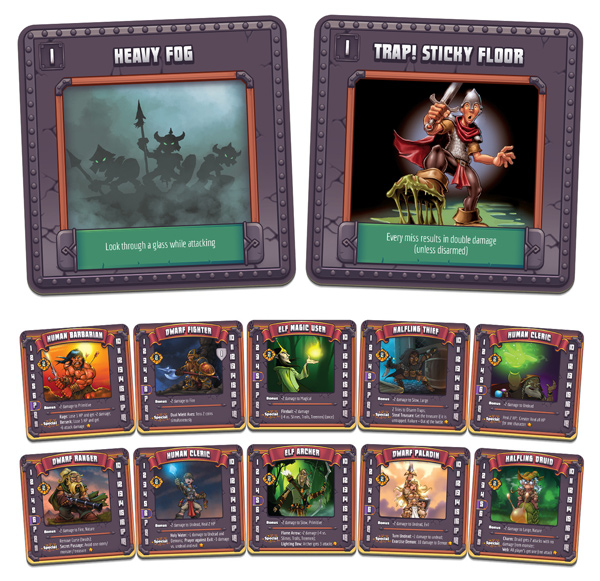First Look: Flick Coins onto Coasters to Slay Monsters in Dungeon Party

Inspired by classic RPG adventures, Dungeon Party is a light, dexterity-based party game played with coasters and coins.
Currently on Kickstarter, Dungeon Party has an adjustable play time, as well as a variety of monsters, curses, traps, treasures, and heroes. We were recently given the opportunity to take a peek at the rules and components for this game and provide our first impressions.
Gameplay
Each player takes a hero coaster. These show your hit points, your hero's special ability, and the monster type they are most effective against. Players then select a dungeon coaster which gives both the back-story of the dungeon, how many rooms are included, and the level of the rooms and monsters. Each room in the dungeon includes a room coaster, a treasure coaster, and a monster coaster.
At the start of each round, you begin by revealing the next room coaster of the dungeon. Different room tiles can have different special effects or rules in play while players are battling the monster in that room. Next the monster coaster is revealed.
Players then take turns bouncing a coin on the table, attempting to land it at least halfway on the monster coaster. If it lands, the monster takes damage based on the hero attacking it and any special effects that might be affecting the attack. If the player misses, his hero takes damage based on that specific monster's attack value. If a hero's health ever hits zero, he is considered knocked out for the rest of the battle with that monster (once the fight is over, all players’ hit points are fully restored). Players keep taking turns bouncing the coin until either all heroes are knocked out (in which case the players lose the game) or the monster reaches zero health and is defeated.
The player who delivers the killing blow on a monster earns that room's treasure; he may choose to pass it off to another player if he wishes. Treasure tokens may simply be valuable items worth more points at the end of the game, or special items or spells, which can be used by different hero types. Each item is worth a certain number of gems and the player with the most gems at the end of the game wins — if the players manage to defeat every room in the dungeon.

First Impressions
Dungeon Party is a clever blend of dungeon crawler and party game. With a 30-90 minute play time (it varies based on the dungeon you choose to tackle) you can easily adapt the game to your group and setting. There is also a wide variety of monsters, treasures, and rooms, and even a fair number of heroes to choose from, to ensure plenty of variety.
The game is also flexible for player age. Yes, the components are coasters, and there as a ‘drinking game’ style variation suggested in the rulebook, but unlike other adult games the components themselves are appropriate for children and the core dexterity gameplay (the default version of the game) is totally accessible to players of all ages
The coasters and coins also ensure that the game can be played in a wide variety of locations with different amounts of space, and the rule book even encourages you to use the coasters for your drinks, implying that they are made from sturdy material that will hold up under repeated use.
In the prototype of the rules we were shown, one or two details could be fleshed out a bit more. For example, there was not a lot of detail on what made for a valid toss or bounce of the coins during the battles, an important detail for a dexterity game. However, these are issues likely to be clarified before release.
It’s great to have such a thematic party game, and a dungeon crawler that’s so versatile for players and setting. Check it out on Kickstarter and decide for yourself if you’re ready for a dungeon party.
Disclosure: this preview is based on our first impressions of a draft of the rulebook and game components, which are subject to change prior to publication. We received a modest payment to write this article.









